Chapter 23
Relational Databases
Chapter Goals
- To learn how to query a database with the Structured Query Language (SQL)
- To connect to databases with Java Database Connectivity (JDBC)
- To write database programs that insert, update, and query data in a relational
database
Relational Database
- Stores information in tables
- Each table column has a name and data type
Product Table in a Relational Database
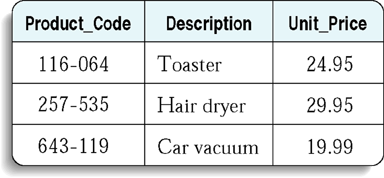
Product Table
- Each row corresponds to a product
- Column headers correspond to attributes of the product
- All items in the same column are the same data type
SQL
- SQL stands for Structured Query Language
- SQL is a command language for interacting with databases
- Most relational databases follow the SQL standard
- Some SQL commands
- QUERY
- CREATE TABLE
- INSERT
- DROP TABLE
Some SQL Types and Their Corresponding Java Types

SQL to Create a Table
CREATE TABLE Products
(
Product_Code CHAR(11)
Description CHAR(40)
Unit_Price DECIMAL(10, 2)
)
SQL to Add Data to a Database
- Use the INSERT command to insert rows into the table
- Issue one command for each row of the table
INSERT INTO Products
VALUES ('3554-0632-1', 'Hair dryer', 29.95)
Linking Tables
- Replicating the same data in multiple rows has two problems
- It is wasteful to store the same information multiple times
- If the data needs to change it has to be changed in multiple places
- Instead you should distribute the data over multiple tables
Poor Design for an Invoice Table with Replicated Customer Data
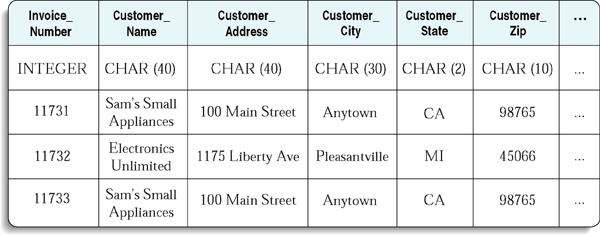
Two Tables for Invoice and Customer Data
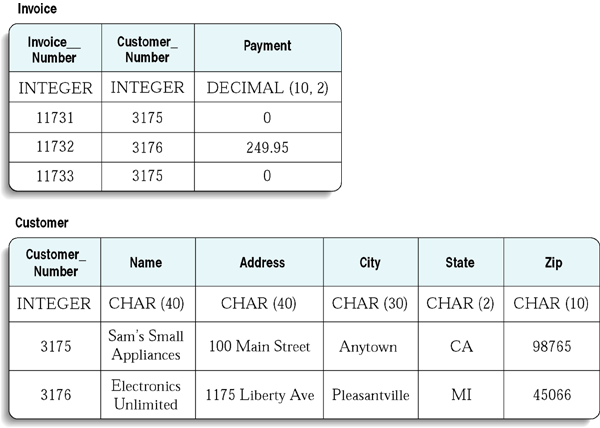
Linking Tables
- In the table above, customer data are not replicated
- Customer table contains a single record for each customer
- Invoice table has no customer data
- The two tables are linked by the Customer_Number field
- The customer number is a unique identifier
Linking Tables
- Primary key is a column (or combination of columns) whose value uniquely
specifies a table record
- Foreign key is a reference to a primary key in a linked table
- Foreign keys need not be unique
Implementing One-to-Many Relationships
- Each invoice may have many items
- Do not replicate columns, one for each item
- Do distribute the information in two tables, invoice and item
- Link each item to its invoice with an Invoice_Number foreign key in the
item table
Poor Design for Invoice Table with Replicated Columns

Linked Invoice and Item Tables
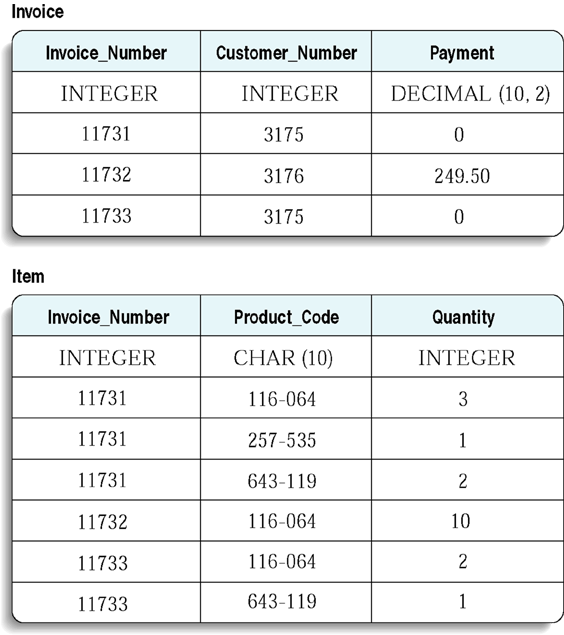
Sample Database
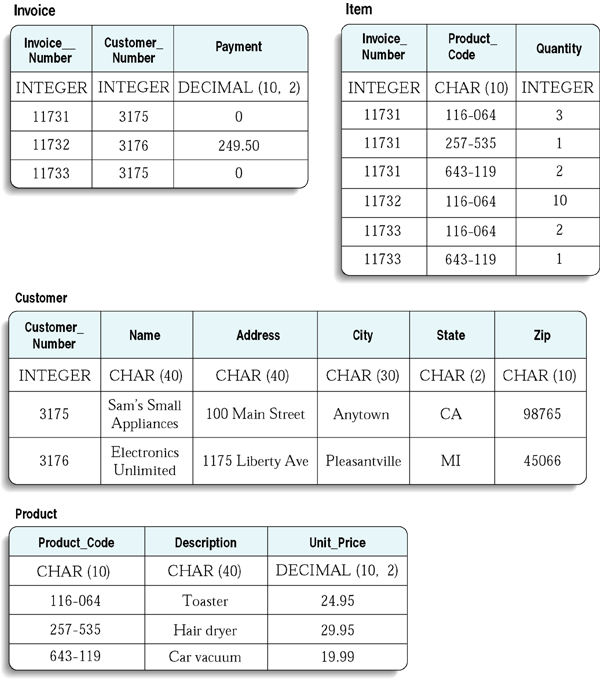
Queries
- Once the database is constructed, we can query it for information
- What are the names and addresses of all customers?
- What are the names and addresses of all customers who live in California?
- What are the names and addresses of all customers who buy toasters?
- What are the names and addresses of all customers with unpaid invoices?
Simple Query
- Use the SQL SELECT statement to query a database
- The query to select all data from the Customer table:
SELECT * FROM customer
- The outcome of a query is a view
- A view is a "window" through which you can see some of the database
Selecting Columns

Selecting Subsets
Result of SELECT * FROM Customer WHERE State = 'CA'

Selecting Subsets
- You can match patterns with LIKE
- The right-hand side is a string that can contain special characters
- Special symbol _ matches exactly one character
- Special symbol % matches any character sequence
- The expression to match all Name strings whose second character is an "o":
Name LIKE '_o%'
Selecting Subsets
- You can combine expressions with logical connectives AND, OR, NOT
SELECT *
FROM Product
WHERE Price < 100
AND Description <> 'Toaster'
- You can select both row and column subsets
SELECT Name, City FROM Customer WHERE State = 'CA'
Calculations
Joins
Joins
- A query that involves multiple tables is a join
- When using a join, do these things
- List all tables that are involved in the query in the FROM clause
- Use the TableName.ColumnName syntax to refer to column names
- List all join conditions in the WHERE clause
(TableName1.ColumnName1 = TableName2.ColumnName2)
Updating and Deleting Data
Updating and Deleting Data
File TestDB.java
File SimpleDataSource.java
File database.properties
Connecting to the DataBase
- Use a Connection object to access a database from a Java program
- Load the database driver
- Ask the DriverManager for a connection
- When you are done, close the database connection
String driver = ...;
String url = ...;
String username = ...;
String password = ...;
Class.forName(driver); //load driver
Connection conn = DeviceManager.getConnection(url,
username, password);
//database commands
conn.close();
Connecting to the Database
- Decouple connection management from the other database code
- You can use the SimpleDataSource class to do this
- Call its static init method with the name of the database configuration
file
- Configuration file is a text file containing four lines
- jdbc.driver = ...
- jdbc.url = ...
- jdbc.username = ...
- jdbc.password = ...
Connecting to the Database
- The init method uses the Properties class to read the file
- Properties class has a load method to read a file of key/value pairs from
a stream
Properties props = new Properties();
FileInputStream in = new FileInputStream(fileName);
props.load(in);
- The getProperty method returns the value of a given key
String driver = props.getProperty("jdbc.driver");
- Now when you need a connection call
Connection conn = SimpleDataSource.getConnection();
Executing SQL Statements
- A Connection object can create Statement objects
Statement stat = conn.createStatement();
- The execute method of the Statement class executes a SQL
statement
stat.execute("CREATE TABLE Test (Name CHAR(20))")
stat.execute("INSERT INTO Test VALUES ('Romeo')")
- Use executeQuery method of the Statement class to issue a query
String queryStatement = "SELECT * FROM Test";
ResultSet result = stat.executeQuery(queryStatement);
- The result of a SQL query is returned in a ResultSet object
Executing SQL Statements
Executing SQL Statements
Executing SQL Statements
- You can reuse a Statement object to execute new SQL commands
- Each Statement object should only have one active ResultSet
- If you need to look at multiple result sets at the same time, create multiple
Statement objects
- Close the current ResultSet before issuing a new query on the same
statement
result.close();
- When you are done with a Statement object, close it
- That will also close the ResultSet
stat.close();
Analyzing Query Results
Analyzing Query Results
Analyzing Query Results
- The other type of get method uses a string parameter for the column
name
String productCode = result.getString("Product_Code");
- Use getInt to fetch an integer column value
int quantity = result.getInt("Quantity");
- Use getDouble to fetch an double column value
double unitPrice = result.getDouble("Price");
Result Set Meta Data
Result Set Meta Data
Result Set Meta Data
File cityzone.sql
File ExecSQL.java
Case Study: A Bank Database
- This is a reimplementation of the ATMSimulation
- In the simulation each customer has a customer number, a PIN, a checking
account and a savings account
- The data will be stored in two tables in a database
Tables for ATMSimulation
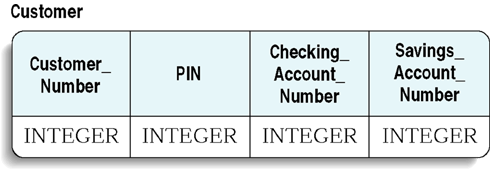
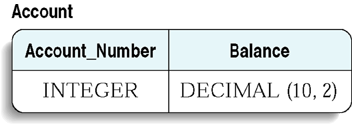
Case Study: A Bank Database
- The Bank class needs to connect to the database whenever it is
asked to find a customer
- Its find method
- Connects to the database
- Selects the customer with the given account number
- Verifies the PIN
- Creates an customer object from the database information
Case Study: A Bank Database
public Customer find(int customerNumber, int pin)
throws SQLException
{
Customer c = null;
Connection conn = SimpleDataSource.getConnection();
Statement stat = conn.createStatement();
ResultSet result = stat.executeQuery("SELECT *"
+ " FROM Customer WHERE Customer_Number = "
+ customerNumber);
if (result.next() && pin == result.getInt("PIN"))
c = new Customer(customerNumber,
result.getInt("Checking_Account_Number"),
result.getInt("Savings_Account_Number"));
result.close();
stat.close();
conn.close();
return c;
}
Case Study: A Bank Database
- The BankAccount methods are different now
- The getBalance method gets the balance from the data base
- The withdraw and deposit methods update the database immediately
File ATMSimulation.java
File ATM.java
File Bank.java
File BankAccount.java
File Customer.java
Transactions
Transactions
Transactions
- Issue the updates that form the transaction then call the commit method
of the Statement class
stat.executeUpdate(
"UPDATE Account SET Balance = Balance -"
+ amount + " WHERE Account_Number = " +fromAccount);
stat.executeUpdate(
"UPDATE Account SET Balance = Balance +"
+ amount + " WHERE Account_Number = " +toAccount);
COMMIT
- If you encounter an error, call the rollback method
- This is usually done in an exception handler
try
{
. . .
}
catch(SQLException exception)
{
stat.rollback();
}
Scrollable and Updatable Result Sets
- Because the result set of a query may be very large,
the ResultSet object does not contain the entire result set
- It is a gateway to a result set stored in the database
- Each time you call next a single row is transferred into the ResultSet
object
- The user may want to look back at previous row.
- Use a scrollable result set to do this
Scrollable and Updatable Result Sets
Scrollable and Updatable Result Sets
- Possible type constants
- TYPE_SCROLL_SENSITIVE
- Result set scrollable
- Result set is updated when other processes change the information
in the database
- TYPE_SCROLL_INSENSITIVE
- Result set scrollable
- Result set is NOT updated when other processes change the information
in the database
- TYPE_FORWARD_ONLY
- Result set not scrollable
- This is the default
- Possible concurrency constants
- CONCUR_UPDATABLE
- You can update the database by editing the result set
- CONCUR_READ_ONLY
- You can NOT update the database by editing the result set
Scrollable and Updatable Result Sets
- Methods for navigating a scrollable result set
- previous() - moves to the previous row
- first() and last() - moves to first or last row
- relative(n) - moves by n rows
- absolute(n) - moves to row number n
- A scrollable result set effectively gives you random access to the result
set
Updatable Result Sets
String accountQuery =
"SELECT * WHERE Account_Number = " + account;
ResultSet result = stat.executeQuery(accountQuery);
Get the value from the Balance column
double balance = result.getDouble("Balance");
Update the balance in the current row, but not in the database
result.updateDouble("Balance", balance + deposit);
Change the data in the database
result.updateRow()
Updatable Result Sets
- Use an updatable result set to insert new rows
- Move the cursor to a special position called the insert row
- Update all column values
- Call updateRow method
result.moveToInsertRow();
result.updateString("Account_Number","54382-5526");
result.updateString("Customer_Number", "992345");
result.updateDouble("Balance",1000);
result.updateRow();
Speeding Queries Up
- Indexing
- Prepared statements
- Stored procedures
Indexing
- If a table has a primary key , the database can build an index file
- Index file stores information on how to access a row quickly when its primary
key is given
- If the primary key is a single column, you can tag the column with the keyword
PRIMARY KEY
CREATE TABLE Products
(
Product_Code CHAR(10) PRIMARY KEY,
Description CHAR(40),
Price DECIMAL(10,2)
)
- A table index can speed up database queries
Prepared Statements
- Use a prepared statement for frequently repeated database queries and updates
- When you send a prepared statement to a database
- The database formulates a query strategy
- Saves it with the prepared statement
Prepared Statements
- To prepare a query to get the bank account information for a given account
String query = "SELECT * WHERE Account_Number = ?";
PreparedStatement prepStat =
conn.prepareStatement(query);
- The ? denotes variables that you fill in when you make an actual query
- Use the set method to set the variables
prepStat.setString(1,accountNumber);
- When you have all variables set, call the executeQuery method
ResultSet result = prepStat.executeQuery();
Stored Procedures
- Are executed in the database kernel
- This is much faster than issuing sequences of SQL commands
- Databases don't all use the same syntax for stored procedures
- You must first download the stored procedure into the database
- You can use the CREATE PROCEDURE statement to do this
Stored Procedures
- A procedure for transferring money from one account to another
CREATE PROCEDURE transfer(
:from INTEGER, :to INTEGER, :amount DECIMAL(10,2)
BEGIN
UPDATE Accounts SET Balance = Balance - :amount
WHERE Account_Number = :from;
UPDATE Accounts SET Balance = Balance + :amount
WHERE Account_Number = :to;
END
- In Java, download a stored procedure by executing SQL statement that defines
the procedure
String definition =
"CREATE PROCEDURE transfer("
+ . . .
+ ") BEGIN"
+ . . .
+"END";
stat.execute(definition);
Stored Procedures
- To call the stored procedure, use the CallableStatement class
- You get a CallableStatement from the prepareCall method
of the Connection class
- The { } tell the JDBC driver that the call is not standard SQL and needs to be translated into the syntax of this database
CallableStatement callStat = conn.prepareCall(
"{call transfer(?,?,?)});
- You need to set values in the ? placeholders before calling the procedure
callStat.setInt(1, fromAccount);
callStat.setInt(2, toAccount);
callStat.setDouble(3, amount);
- Call the procedure
callStat.execute();











